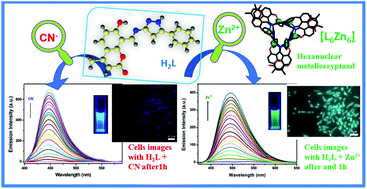Idiosyncatic recognition of Zn2+ and CN− using pyrazolyl-hydroxy-coumarin scaffold and live cell imaging: depiction of luminescent Zn(ii)-metallocryptand†
Abstract
Multi-responsive and selective sensor design is one of the stimulating research areas in the sensors field. We have designed a pyrazolyl-hydroxy-coumarin scaffold, 7-hydroxy-4-methyl-8-(((5-phenyl-1H-pyrazol-3-yl)imino)methyl)-2H-chromen-2-one (H2L) and characterized it by spectroscopic techniques (1H NMR, 13C NMR, ESI-MS, IR). The single crystal X-ray diffraction measurement confirms the molecular structure of the probe. It shows the selective sensing of Zn2+ in the presence of sixteen other cations with ‘Turn On’ approach through the enhancement of green florescence ((λem = 499 nm; λex = 390 nm) in CH3CN/H2O (99 : 1, v/v; HEPES buffer, pH 7.5) medium with the limit of detection (LOD) of 34.76 nM. The structural depiction of the isolated Zn2+ complex reveals cage like metallocryptand cyclic hexamer, [Zn6L6] with 30.9% void of cavity along the crystallographic c axis of approximate dimension of 7.502 × 7.050 × 7.068 Å3. The diffusion NMR study reveals only one type of complex in the solution, having 1 : 1 composition, i.e., Zn2+ : H2L, which affirms the isolated form of the complex. On the other hand, the receptor, H2L, recognizes the very noxious anion CN− out of sixteen anions. The product identification using spectroscopic techniques supports the nucleophilic addition of CN− across the exocyclic imine (C![[double bond, length as m-dash]](https://www.rsc.org/images/entities/char_e001.gif) N) bond, which shows blue emission ((λem = 447 nm; λex = 390 nm), and the LOD was 19.91 nM. The composition of [H2L−Zn2+] and [H2L−CN−] was established by 1H NMR titration, Job's method, ESI-MS, and FTIR spectra. The efficacy of the probe was further studied using MTT assay in MDA-MB 231 and WI-38 cell line as well as for the intracellular imaging of Zn2+ and CN− using a fluorescence microscope. Flow Cytometry was further performed for the quantitative analysis of Zn2+ distribution in MDA-MB 231 cells.
N) bond, which shows blue emission ((λem = 447 nm; λex = 390 nm), and the LOD was 19.91 nM. The composition of [H2L−Zn2+] and [H2L−CN−] was established by 1H NMR titration, Job's method, ESI-MS, and FTIR spectra. The efficacy of the probe was further studied using MTT assay in MDA-MB 231 and WI-38 cell line as well as for the intracellular imaging of Zn2+ and CN− using a fluorescence microscope. Flow Cytometry was further performed for the quantitative analysis of Zn2+ distribution in MDA-MB 231 cells.



 Please wait while we load your content...
Please wait while we load your content...